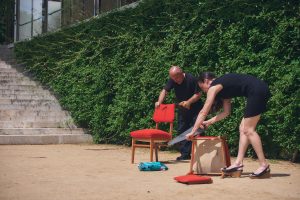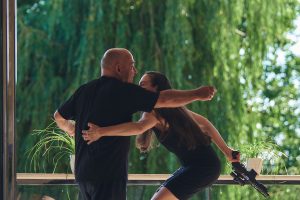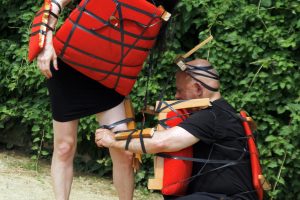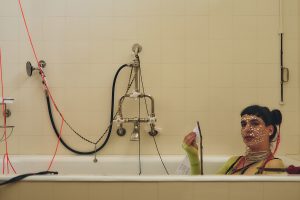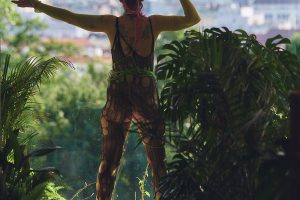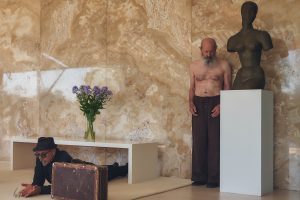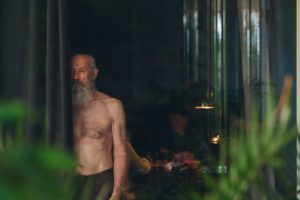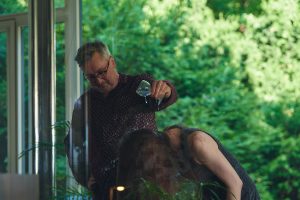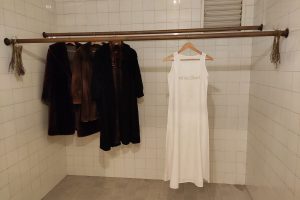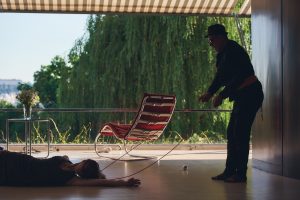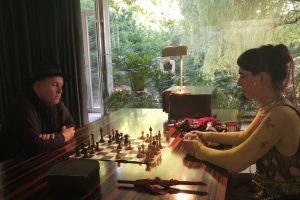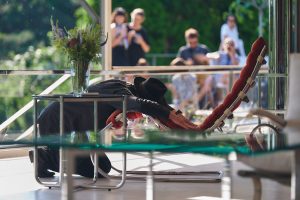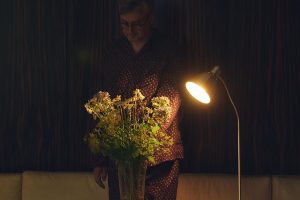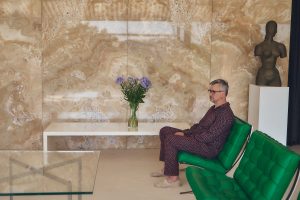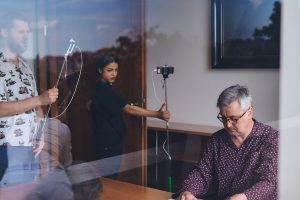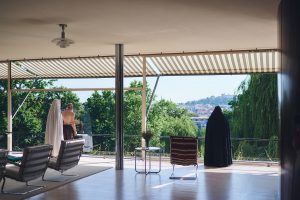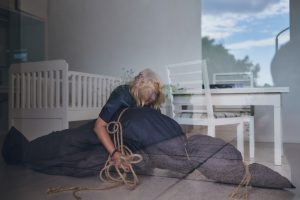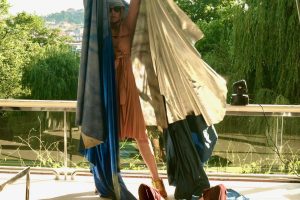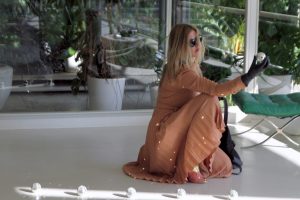Łukasz GUZEK
Revisiting the Tugendhats. Performance in situ
28 June 2021 was an extremely hot day in Brno. Villa Tugendhat looked beautiful with its flower gardens. This masterpiece of high modernism by Ludwig Mies van der Rohe in collaboration with interior designer Lilly Reich, here fully presented not only its unique form, but also its relationship with the environment, the free flow of internal / external space, the decorative elements of the interior, and above all the naturally patterned onyx wall and tropical woods juxtaposed with the lush flora and iron framework, and the glass façade that opens by sliding down into a slot in the structure of the floor along the wall, like an automobile window. It was in these circumstances that the performers entered the space of Villa Tugendhat.
The performers at the villa were selected by Tomáš Ruller. He was invited to create an event by the Villa Tugendhat museum curator, Neli Hejkalová. Museums cannot be dead, museums must be living. To make this possible, the art museum needs to be brought closer to contemporary art itself. And what is closer to contemporary life than performers and live art. It just so happens that in Brno there is a great world centre of performance art at Brno University of Technolgy, which has been animated by Ruller since the beginning of the nineties, i.e. since the collapse of the totalitarian system in Central Europe. A small performance art festival at the Tugendhat estate was organized by him in accordance with the assumptions of his project Open Situation, which is a performance form invented and curated by him from time to time since 1984. The first Open Situation festival took place in Prague in 1989 and then again many times around the world, from Poland, to China and the USA. They featured a variety of personal compositions, as the groups of participants were more or less numerous and they always came from different countries and cultures. This feature of international performers is a principle worth emphasizing, because it presents art as an opposition to the nationalisms and cultural dominations that continue to grow in power in contemporary politics.
The rule of Open Situation is the chief idea forming Black Market, an international movement of performers of which Ruller (and Piotrowski) are among founders. The principle of their events was to act jointly, but also individually. The dialectic linking the collective and individualism was to result in a new, holistic work. This is the principle of intermedia by Dick Higgins, where a whole composed of many elements is not just their sum, but a unity in which the elements are fused and integrated together inseparably as a new work. The activities of the Open Situation series are also based on this principle. The title contains a short description of the principle in operation – openness to the environment and the presence of others. And the ‘here and now’ is the basic material from which the collective work is made.
In Brno, this ‘here and now’ was the modernist space of Villa Tugendhat, with its high modernism design furnishings. It turns out that modernism perfectly fits the assumptions of Open Situation. The principle of forming a modernist space assumes its unity, and the divisions are either temporary, movable (like curtains, sliding walls) or, when fixed, they allow movement in space, and do not constitute a barrier or barricade and do not separate rooms, but allow the flow between individual sections of the room. It does not mark fixed and confined spaces, but points towards and indicates places of possible activity for people in the room. Thus, the dialectic of collective and individual action may find here a final and perfect fulfillment. The artists let into such a space were not forced to choose the position of their action, but could move through the space creating a dynamic, performative work. In addition, utility rooms and areas such as staircases, lobbies, bedrooms or a children’s room were places for individual activities. A context for the actions was also created by the possibility of interacting with the splendid historical interior designs and the conclusion was a meeting in the common space – in the Tugendhat lounge.
The performances were therefore a study of the architecture of the villa. It was performative research carried out by the use of the artists own body, phenomenologically following Maurice Merleau-Ponty. The application of the phenomenological method via performance art involved an insight into the existing realities of the villa, treated as given, and its description through direct action, i.e. perception through the body. The artists entered the reality of the villa from their world, their art. Even if they had prior knowledge of this venue, it became a new place for their art, alien to their cognition through the body as a performance practice. So they had no preconceptions about how to operate inside the villa. It is a phenomenological epoche (or Open Situation). Thus, in accordance with the phenomenological assumption of cognition, they could enter the villa as it is, with all the features of Mies van der Rohe’s design, but also the museum restrictions. However, it was not about exploring them, but rather regarding what is given and obvious as the ‘here and now’. About physical contact with the place via the body bringing forth a creative energy.
The set of individual performances began with Ruller in the basement of the villa. With two mobile cameras in his hands (and one in his chest pocket), he examined the perfection of the ventilation system, entering places usually inaccessible to the museum’s onlookers. At the same time as the flow of air circulation constitutes a vital system of the architecture, it also evokes the technology of gas chambers. Zygmunt Piotrowski (PL) made his performance also in the basement. He usually presents elements of his psycho-physical condition, in short – himself as a work of art. Here, he based his action on an experience that traumatized his own body – against his back his arms were pressed tightly and tied with a belt. It caused a gradual increase in suffering experienced and was performed until he was unable to do it longer. János Szirtes & Ágnes Éva Molnár (HU) performed on the lower terrace in front of the audience gathered in the garden. The props for their joint performance were two identical chairs. Performance in pairs speaks of the relationship that is visualized during the action. In this case, the two artists cut their chairs into pieces and fastened the parts to their partner’s body. The artists, acted individually, but at the same time, created two visually similar living sculptures, performance objects, which at the end took a walk around the villa, finishing by helping each other to dismantle these added parts and return to normal. Rokko Juhász (SK) started in the lobby at the main entrance, then moved through the rooms of the villa accompanied with his performer-traveler’s suitcase. He took out of it one by one props and marked his path. They were glasses of various sizes, set as if they were about to overturn in an unstable manner, how unstable functioning reality is. In the living room he looked through a bookcase and on a large round table he placed a toy train moving around. His last stop was an area in the garden, where the prime ministers of the Czech Republic and Slovakia, Václav Klaus and Vladimír Mečiar, came to an agreement (signed at the round table) to divide Czechoslovakia into two countries – the suitcase was placed on the chairs facing each other on which they sat, as an object concluding the action, a post-performance object, referring to the contemporary history of the villa. After returning to the villa, there was a performance of the Projekt <8> collective, which is formed of Veronika Bromová & Veronika Drahotová + guest Tomáš Pospiszyl (CZ). They chose the private rooms of the former residents of the villa for their activities. Veronika Bromová performed in the nursery, referring to the family stories of the Tugendhat family – after making an emballage object, she placed a bundle tied with a rope into a crib, tidied herself in front of the mirror and left. Veronika Drahotová showed us the possibilities of her picture puzzles by manipulation. Tomáš Pospiszyl played the role of the master of the house who having just left his bedroom in his pijamas, is doing some important activities such as contemplating the pictures of his partner. The whole thing gave the impression of a surreal dream-like scene. Here and there in the various rooms and in the garden, you could find boards with inscriptions. This was the activity of Jana Orlova (CZ), and consisted of spreading a poem out into sections of words and giving it a spatial form integrating the entire villa and the surrounding garden. The performer, dressed in an evening dress, sneaked around the villa during other actions, leaving written traces of her presence. Text was also an important element of the performance by Darina Alster (CZ). The performer was dressed in the style of Vivienne Westwood postpunk in erotic dancer shoes, with Svarovski’s cristals on her face, she looked beautiful, like a jewel or a Byzantine mosaic (on the pattern of Maori tattoos). In the bathtub, she read excerpts from her text about “post-structural performance”. Both the text and the perfo image complemented each other like an art based research project. However, it was in stark contrast to the modernist setting. Both artists are working on their PhD theses on performance issues.
Finally, everyone met in the living room. It was as if it was a meeting of the spirits of the place, those inhabiting the villa who appeared to have been called by the curators of the project. It could have certainly been perceived in this way by the audience gathered in the garden, looking at the strange behavior of people behind the glass wall or through the lowered large windows. It was like a surreal film in the spirit of Luis Buñuel watched live, who in such films as Un Chien Andalou, L’Age d’Or or The Exterminating Angel and Le charme discret de la bourgeoisie showed in a satirical way the haute bourgeoisie to which the Tugendhats also belonged. Their luxurious villa is a perfect scenery for social criticism via art. The visual image they watched filmed before their eyes was full of contradictions. The composition of Open Situation was based on improvisation, it was jazz-jamming performance. Piotrowski appeared meditating (or levitating) in the window, half-dressed like an old Hindu guru from Rajasthan (or from the Mircea Eliade book on Yoga). Ruller and Juhas wore an all black dress code like the Blues Brothers of the 21st century, or existential philosophers or reverends. Veronika Drahotová, the lady of the house, performed in elegant fine luxury like a rich well-dressed lady, as did Orlova. This contrasted with the punk outfit of Alster who nevertheless looked quite natural within the green plants filling the villa profusely, while Pospiszyl continued as the landlord in pijamas and slippers. The couple, Szirtes & Molnár, carried on playing together using a variety of props, plastic toys, or electric tools. Bromová dressed up for the work of a performer in a baseball cap, also spread a round black and white mandala tablecloth on the big round table. Finally, all participants sat down together at the table and in the composition of this Open Situation, that final action indicated the end of the event.
The end of modernism at Villa Tugendhat – this is how one could sum up this festival. Performance mediated between modernism and postmodernism. Live action, dynamism, chance, unpredictability, body expression, sexuality, in forms drawn from the menu of world art, appeared inside the pinnacle of modernism’s achievements. Postmodern ‘anything goes’ has been filled with content. Also with political content. The modernist avant-garde with its utopian objectivity has been replaced by the in situ research of everyday life existance. Modernism has been overpassed and incorporated into one of the Open Situation situations.
It was not possible to see everything directly. Part of this was due to the limitations of the Covid pandemic and partly due to limitations in the number of visitors allowed to enter the museum at once. Hence, most of the activities were performaces for camera type of works. Each performance was broadcast from several cameras, both as live streaming to the internet and on monitors set up outside the villa (a media work by Michal Kindernay (CZ) – video & streaming). So the villa was turned into a video installation. The results of this Open Situation can be viewed online as well as on the technical floor of Villa Tugendhat (intended for exhibition purposes). Photos and video screenings of documentation is presented in the form of an exhibition from 8th July – 1st August 2021 (accessible Tue – Sun 10: 00 – 17: 30). Open Situation curated by Ruller is the first event in the Possibilities of Interpretation series, curated by Hejkalová, in which Villa Tugendhat will be the subject of artistic activities, the results of which will be shown at subsequent exhibitions at the villa-museum until February 2022.
More on:
https://www.tugendhat.eu/en/interpretation-1.html
https://www.tugendhat.eu/en/possibilities-of-interpretation-1.html

